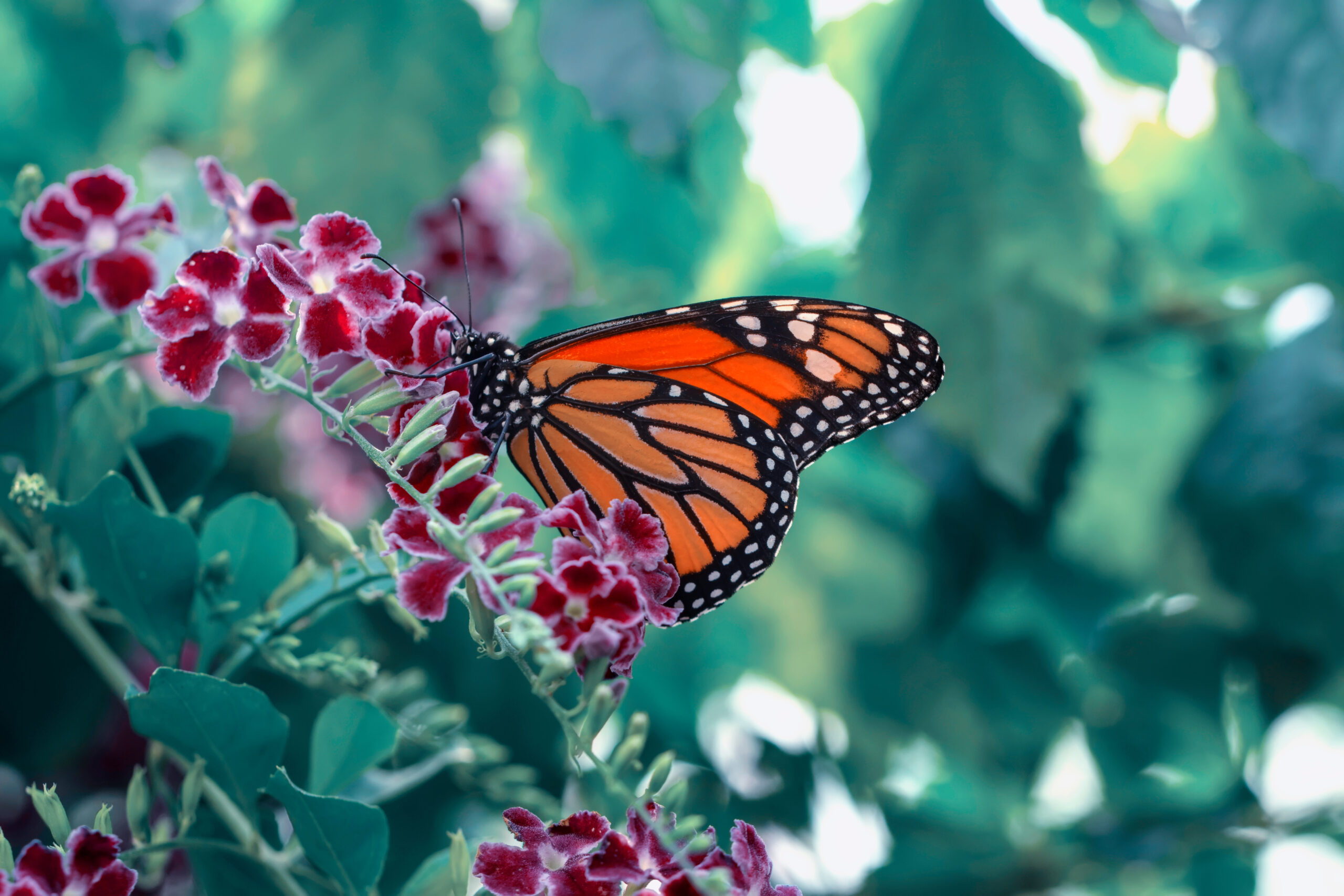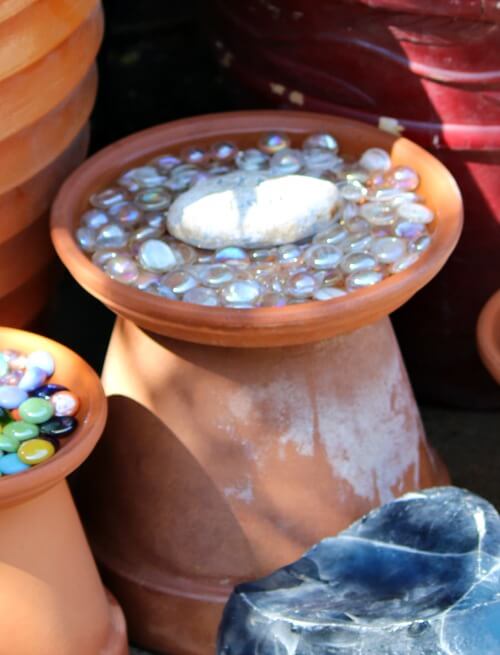Monarch Butterfly Meets Honey Bee Photograph by Dancasan Photography

Monarch Butterfly and Bee sharing a flower. Chaste tree, AKA
A teaspoon of chlorine bleach in a bucket of water may be enough to get the bees' attention. Other beekeepers add a handful of ground oyster shells to a pie pan of water, which gives the water a faintly salty ocean smell the bees find attractive. Alternatively, you can use a weak sugar solution in a bee waterer.

Monarch Butterfly Meets Honey Bee Photograph by Dancasan Photography
This simple DIY water feeder is made from an old grapevine wreath, a pie plate, and stones. It's an additional way to ensure butterflies and other pollinators have fresh water available in the garden.. Water Feeder for Bees, Birds, and Butterflies . Sometimes the simplest ideas work best! I made this water feeder from an old grape vine.

What plants help bees and butterflies? Los Angeles Times
800 worker bees are responsible for collecting all the water for the hive. It takes each of these worker bees an average of 50 trips a day to collect the quart of water that the colony needs to survive. On hot days, this need can expand to as much as a gallon of water. When it does, more bees are temporarily assigned to water collection.

How to encourage butterflies and bees into your garden Premier Lawns
A classic example is the monarch butterfly, which depends solely on milkweed as a larval (the developmental stage) host plant. Milkweed is the only plant that supports monarch eggs and caterpillars. Some butterflies rely on several larval host plants where they lay their eggs and the caterpillars can eat the leaves.

Here’s How You Can Attract Bees And Butterflies To Your Garden Chip Chick
Pollinator-friendly garden kits. Make your garden a welcoming habitat for your neighborhood bees and butterflies with our beautiful all-zones appropriate bee-friendly garden and butterfly garden kits. A great way to let everyone know that you avoid pesticides and grow flowering plants to support our hard-working pollinators!

Butterfly and bee on flower by KeenPhotography on DeviantArt
6 ways to show our gratitude to bees, butterflies and other vital pollinators.. Tip: Reward these busy bodies by making a bee water fountain. These little ones need water after buzzing around all day. Leaving a clean, shallow water bowl, with rocks or sticks in it so that bees don't drown, is a good way to give the bees a resting spot and.

Bee and Butterfly Corel Discovery Center
Just like bees, butterflies can't land on water and would appreciate a safe spot to rest and drink. 2. Repurpose a Hummingbird Feeder. Bees siphon up liquids with a straw-like tongue, or proboscis. When fully extended, the proboscis is roughly a quarter of an inch long so bees can reach into the deepest recesses of flowers and access the.

Bees and Butterflies Craft Supplies & Tools Cord & Lacing
Arrange some rocks in the pan so the butterflies have a place to land. Cut a kitchen sponge into various shapes and arrange the sponges between the rocks, or put one large sponge in the center of the plate. Keep the sponges damp so the water slowly seeps to keep the soil moist. Put the puddler in a sunny, protected area near butterfly-friendly.

Everyone can make a bee/butterfly drinking dish just use a shallow bowl
Bees are the most important pollinators, but over 100,000 invertebrates—including butterflies, moths, wasps, flies, and beetles—and over 1,000 mammals, birds, reptiles and amphibians, act as pollinators. Unfortunately, pollinators are in decline worldwide. Habitat loss, invasive species, parasites, and pesticides are largely to blame.

Bees, Butterflies, and Hummingbirds What to plant to help pollinators
Deanna Kizis / Sunset. Pour in clean water. Add a sprinkle of salt, which will attract both butterflies and bees. ( Don't add sugar or honey. Not only could you get hundreds of bees, the colony could get lazy, pollination will suffer, and they'll make watery honey.) Told you it was easy!

Create A Bee & Butterfly Water Source · Cozy Little House
However, if your water smells rotten, it's time to dump it out and start fresh. Bee Waterers 2.0 and 3.0. Since we weren't seeing bees or butterflies in the first waterer after a week or so, I decided to create a couple more waterers with materials we had on hand. We can keep experimenting to find the setup that works best in our garden.
Drink Station Ideas Restaurant Amazing Cafã© And Coffee Shop
Insect watering dish: Fill the same kind of shallow dish with water and add . decorative landscape stones. The stones will serve as landing places for butterflies and other insects trying to get a sip of water. Birds and other wildlife can get a drink too. Fruit Feeders: Butterflies also consume nutrient-rich liquid from rotting, fermenting fruit.

How to Make a Waterer for Bees and Butterflies in 2021 Water for bees
Butterflies, bees, and other pollinators are so important to our gardens and food supply. And there are little things we gardeners can do to help them, like making a pollinator water station. I happily attended the DIY Butterfly Puddler Workshop at Ken's Gardens in Lancaster to make my own pollinator watering dish.

How to Make a Waterer for Bees and Butterflies
Leaving some areas of bare soil for ground-nesting bees and providing water sources like shallow dishes or birdbaths can further enhance your garden's appeal to pollinators as well.. Every flower you plant and every habitat you create contributes to the well-being of bees, butterflies, birds, and other pollinators. Together, we can make a.

How to Make a Waterer for Bees and Butterflies
Each bee will collect around 25mg of water during approximately 50 trips. If there is insufficient water, the worker bees will stop foraging and begin water collection duties. During the height of summer, a typical hive would require several liters of water daily. (Visited 175 times, 1 visits today) ← Previous Post.

Best plants for bees and butterflies Trendradars Latest
Pollinator beds feature a variety of colors and shapes through the seasons and attract bees, butterflies and birds. But because they draw bees, don't plant them near your front door or sidewalk.